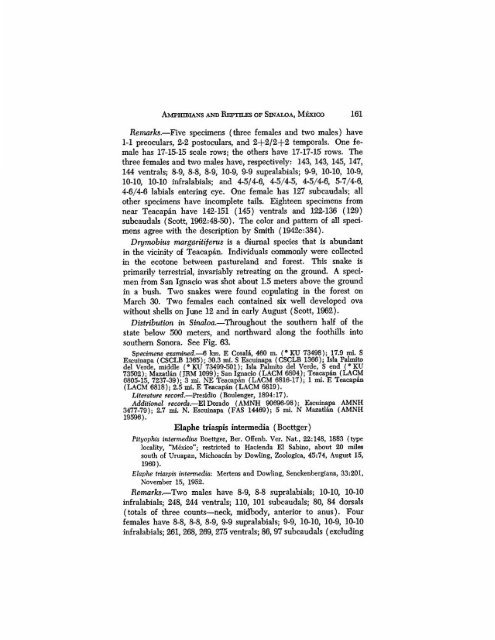The Amphibians and Reptiles of Sinaloa, Mexico - Smithsonian ...
The Amphibians and Reptiles of Sinaloa, Mexico - Smithsonian ...
The Amphibians and Reptiles of Sinaloa, Mexico - Smithsonian ...
Create successful ePaper yourself
Turn your PDF publications into a flip-book with our unique Google optimized e-Paper software.
AMPHIBIANS AND REPTILES OF SINALOA, MEXICO 161<br />
Remarks.—Five specimens (three females <strong>and</strong> two males) have<br />
1-1 preoculars, 2-2 postoculars, <strong>and</strong> 2+2/2+2 temporals. One female<br />
has 17-15-15 scale rows; the others have 17-17-15 rows. <strong>The</strong><br />
three females <strong>and</strong> two males have, respectively: 143, 143, 145, 147,<br />
144 ventrals; 8-9, 8-8, 8-9, 10-9, 9-9 supralabials; 9-9, 10-10, 10-9,<br />
10-10, 10-10 infralabials; <strong>and</strong> 4-5/4-6, 4-5/4-5, 4-5/4-6, 5-7/4-6,<br />
4-6/4-6 labials entering eye. One female has 127 subcaudals; all<br />
other specimens have incomplete tails. Eighteen specimens from<br />
near Teacapan have 142-151 (145) ventrals <strong>and</strong> 122-136 (129)<br />
subcaudals (Scott, 1962:48-50). <strong>The</strong> color <strong>and</strong> pattern <strong>of</strong> all specimens<br />
agree with the description by Smith (1942c:384).<br />
Drymobius margaritiferus is a diurnal species that is abundant<br />
in the vicinity <strong>of</strong> Teacapan. Individuals commonly were collected<br />
in the ecotone between pasturel<strong>and</strong> <strong>and</strong> forest. This snake is<br />
primarily terrestrial, invariably retreating on the ground. A specimen<br />
from San Ignacio was shot about 1.5 meters above the ground<br />
in a bush. Two snakes were found copulating in the forest on<br />
March 30. Two females each contained six well developed ova<br />
without shells on June 12 <strong>and</strong> in early August (Scott, 1962).<br />
Distribution in <strong>Sinaloa</strong>.—Throughout the southern half <strong>of</strong> the<br />
state below 500 meters, <strong>and</strong> northward along the foothills into<br />
southern Sonora. See Fig. 63.<br />
Specimens examined.—6 km. E Cosala, 460 m. (• KU 73498); 17.9 mi. S<br />
Escuinapa (CSCLB 1365); 30.3 mi. S Escuinapa (CSCLB 1366); Isla Palmito<br />
del Verde, middle ('KU 73499-501); Isla Palmito del Verde, S end {"KU<br />
73502); Mazadan (JRM 1099); San Ignacio (LACM 6804); Teacapan (LACM<br />
6805-15, 7237-39); 3 mi. NE Teacapan (LACM 6816-17); 1 mi. E Teacapan<br />
(LACM 6818); 2.5 mi. E Teacapan (LACM 6819).<br />
Literature record,—Presidio (Boulenger, 1894:17).<br />
Additional records.—El Dorado (AMNH 90696-98); Escuinapa AMNH<br />
3477-79); 2.7 mi. N. Escuinapa (FAS 14469); 5 mi. N Mazatlan (AMNH<br />
19596),<br />
Elaphe triaspis intermedia (Boettger)<br />
Pityophis intermedium Boettger, Ber. Offenb. Ver. Nat., 22:148, 1883 (type<br />
locality, "<strong>Mexico</strong>"; restricted to Hacienda El Sabino, about 20 miles<br />
south <strong>of</strong> Uruapan, Michoacan by Dowling, Zoologica, 45:74, August 15,<br />
1960).<br />
Elaphe triaspis intermedia: Mertens <strong>and</strong> Dowling, Senckenbergiana, 33:201,<br />
November 15, 1952.<br />
Remarks.—Two males have 8-9, 8-8 supralabials; 10-10, 10-10<br />
infralabials; 248, 244 ventrals; 110, 101 subcaudals; 80, 84 dorsals<br />
(totals <strong>of</strong> three counts—neck, midbody, anterior to anus). Four<br />
females have 8-8, 8-8, 8-9, 9-9 supralabials; 9-9, 10-10, 10-9, 10-10<br />
infralabials; 261, 268, 269, 275 ventrals; 86, 97 subcaudals (excluding
















